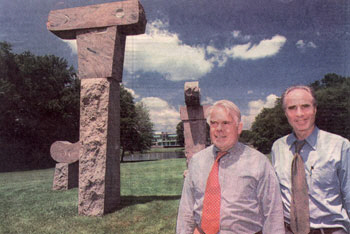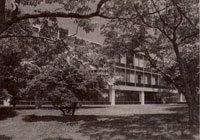Class News
Tyler Smith '64 in a fight over an insurance office
The New York Times
Sunday, July 16, 2000
In 1957, the Connecticut General Insurance Company abandoned Hartford, the insurance capital of the world, for suburban Bloomfield. The company's president, Frazer B. Wilde, commissioned a mammoth company headquarters, designed by a world-renowned architect and sculptor to be set amid hundreds of pastoral acres.

Jared Edwards, left, and Tyler Smith of Smith Edwards
Architects, Hartford, stand near a Noguchi sculpture
on the Cigna corporation grounds in Bloomfield.
The buildings and grounds are regarded as historically
significant by many architects.
Forty-three years later, the company, now known as the Cigna Corporation, is planning to reduce its ownership of the land to less than 30 acres. The rest will be sold to developers. The flagship building and one other will make way for a golf course, hotel and houses. Its proposal to sell the property has already passed one round of town approvals and has the support of Bloomfield's mayor.
The architectural community, however, is outraged. Although the buildings are deep in the suburbs and are, after all, just the offices of another insurance company in a region that has plenty, many architects say the buildings and their grounds are historically significant.
"Frazer Wilde's plan redefined the American workplace," said Tyler Smith of Smith Edwards Architects, a Hartford firm that is leading the effort to save the buildings. "The Wilde building is as cultural significant as Samuel Colt's factory 100 years ago."
Mr. Smith and the other principal of the firm, Jared Edwards, are enlisting the aid of their high-profile colleagues, architects like Robert A. M. Stern, the dean of the Yale University School of Architecture, and David M. Childs, chief architect for Skidmore, Owings & Merrill, the firm chosen by Mr. Wilde more than 40 years ago to build his dream corporate campus, as well as directors from the Museum of Modern Art and both the National and the Connecticut Trust for Historic Preservation.
At stake is the fate of two modern corporate buildings: the 827,000-square-foot Wilde building as well as the 570,000-square-foot North Building, once the headquarters of the Emhart Corporation, a hardware company. Both buildings were designed by Gordon Bunshaft, a leading proponent of International Style, which is characterized by pure geometric shapes, an absence of ornamentation and a reliance on engineering principles to convey structure. Among Mr. Bunshaft's designs are Lever House in New York City and the Beinecke Rare Book and Manuscript Library at Yale University.
The Wilde Building features four interior courtyards and sculpture by Isamu Noguchi, a sculptor and landscape designer whose work is featured in the Unesco building in Paris and the sunken sculpture garden at the Beinecke Library. Cigna executives said Mr. Noguchi's work "The Family," an exterior sculpture on its Bloomfield campus, will be sold to developers along with the rest of the property, a subject of concern, along with the proposed destruction of the courtyards, to directors of the Isamu Noguchi Foundation and Museum, said Amy Hau, administrative director of the Foundation in New York.

The main building on the campus of
the Cigna Corporation. The
company wants to sell most
of the grounds to developers.
The North building, across the street from the Wilde complex, was Gordon Bunshaft's first poured-concrete building. Its cantilevered design gives it the effect of floating.
Executives for Cigna have dismissed the outcry from the architectural community as the inflated opinion of impractical elitists.
"Cigna's history and tradition is not a building," said Kenneth J. Ferraro, director of public relations for the company. "It's providing competitively superior value and service from its employees to its customers and shareholders. This development proposal allows us to continue to do this."
The existing buildings, Cigna executives said, are too big, too costly to operate and outmoded for today's technology. While the Bloomfield campus houses more than 4,500 employees, the company headquarters moved to Philadelphia in 1982, shortly after Connecticut General merged with Insurance Company of North America.
The architects said Frazer Wilde was among the first to change where corporate America worked in the 1950's, by moving to the suburbs and commissioning cutting edge architects and artists as well as the designer Florence Knoll, who designed the streamlined furnishings in the building and went on to form Knoll Furniture.
Mr. Wilde also influenced how corporate America worked. The open-floored, three-story Wilde building featured 360-degree views of ponds, gentle hills and wildflowers. It also included a bowling alley, a hair salon and a boutique-sized Lord & Taylor department store. Yet Cigna executives said the needs of its work force have changed.
"Employees today are less interested in making work their whole world," said Anthony J. Paticchio, assistant general counsel in investment law for Cigna. "They're more concerned about a diverse work force, competitive salaries and things like parking."
When it was unveiled, the Wilde building was the new thing, earning accolades from magazines like Time and Fortune and awards from the architectural community. The building was a departure from its peers, buildings that were more typically stone and ornately designed. By contrast, the enormous yet sleek Wilde building sheathes its steel skeleton in a green-hued glass skin. The building is one large rectangle attached to smaller rectangles on the south, west and north sides. The rectangularity of its exterior is echoed in the multi-sized rectangular windows; from inside, the rolling acreage appears through the windows as a series of framed landscapes. The ceilings soar and the corridors are enormous and often open to courtyards, whose doors are locked but the space features a bench or two. The sheer size of the space makes an airport terminal seem cozy. It is the dream work place of a claustrophobe.
Yet it is the very size of the building and its horizontal layout that is most bothersome to the Cigna executives.
"If you look the company archives, the building was designed along the lines of a light manufacturing model," said Mr. Ferraro. "People moved paper around like a human conveyer belt. We don't work that way anymore." Both he and Mr. Paticchio commended the building's usefulness in Wilde's time.
Mr. Smith and Mr. Edwards describe the Wilde building as a model of meritocracy, designed so the company president was spotted in the building as easily as a filing clerk. The horizontal design was a physical reaction against the hierarchy of corporate America.
Cigna's response?
"It was never about the romantic notion of creating a meritocracy," Mr. Ferraro said. "That notion was applied to justify it as an architectural monument. In its day, 2,000 people were on a schedule and a whistle was used to call them to lunch."
Company executives estimated that to merely maintain the building's mechanicals and increase the wiring necessary for merely adequate - never mind state of the art - computer technology will cost $40 million over the next seven years.
But Mr. Childs, whose firm, Skidmore, Owings & Merrill, is restoring the exterior of the Bunshaft-designed Lever House in New York, said adaptation of the Wilde building is indeed possible if the idea that the building is a cultural landmark is adopted. Much older buildings with significant challenges to modern adaptation have been restored and renovated.
"The property is the prototype for the suburban corporate park," Mr. Childs said. "Too often in America when something becomes outmoded, we just throw it away when it could be adapted and treasured as part of our cultural history."
His colleague, Mr. Stern, said that the kind of architectural patronage of the 1940's and 50's, as evidenced by the Seagram, I.B.M. and Connecticut General buildings, is not seen today. Instead, corporate architecture tends to be anonymous, built by developers to be leased to corporations, Mr. Stem said.
Another hurdle is the preservation movement itself. The cherishing of Modern buildings is a relatively nascent concept outside the architectural community. Modern buildings are held to a much higher standard than their antecedents, Mr. Stem said.
"The preservation movement grew up in protest to the destruction of some buildings of the 19th and 20th century to make way for International Style buildings," he said. "This movement tends to be skeptical about the merit of these buildings."
Unlike New York City, where buildings can be made landmarks for preservation, organizations seeking protective status for Connecticut buildings cannot do so without the permission of the building owner. Although the State Historical Commission and State Historic Preservation Office have said that the Connecticut General campus merits preservation, these organizations cannot halt demolition. The campus will be proposed by Smith Edwards Architects for listing on the state and national registers of historic places.
Nor can the Connecticut Trust for Historic Preservation prevent demolitions of historic properties in the state. Christopher Wigren, assistant director for the group, said his organization has no regulatory powers. At the moment, Mr. Wigren said the group is collecting information on buildings similar in style and period to Bunshaft's that were successfully adapted to new uses, such as the Reynolds Metal building in Virginia and the General Motors headquarters in Michigan.
The next challenge for the Cigna proposal is a town planning and zoning meeting on Wednesday. Several zone changes for the property will be reviewed.
With the raging real estate market, Cigna plans to sell almost all of its 650 acres to developers. They have worked out a master plan with the assistance of Elkus/Manfredi, a Boston architectural firm. It includes an 18-hole Arnold Palmer-designed golf course, a 275-room hotel and conference center where the Wilde building now stands.
The residential component of the plan includes 158 single family houses priced at about $275,000 and 240 "luxury" apartments. The 4,600 employees will move to the company's remaining 30-odd acres on the southern part of the campus where the South building now stands. Two new buildings will be added by developers and Cigna will lease space from the owners. As of yet, no developers have been hired.
Both Connecticut General and Cigna have kept the 650-acre site open to the public. Anyone can meander the property. Bikers and joggers are a common sight as are soccer and tennis players on the company's fields and courts. Tom Hooper, the town planner, said many Bloomfield parents have taught their children to drive on the quiet roads of the campus. Although plans for the new site will feature a public golf course, the development proposal will certainly change the public's use of the property, yet officials said very few people are complaining.
"There's tremendous support for the proposal everywhere I go," said Faith McMahon, who has been Bloomfield's mayor since 1993. Cigna is far and away the town's biggest taxpayer. In 1999, the corporation paid $198,376,324 in taxes; the second highest tax revenue was $23,120,338 paid by the Kaman Corporation.
The proposal seems to have quelled an uncertainty about the corporation's commitment to the town since the company moved its headquarters from Bloomfield to Philadelphia in 1983.
"One thing we've always worried about with regard to Cigna is the diversity issue," Ms. McMahon said, referring to the town being so dependent on one company for tax revenue and jobs. "This plan offers diversity and the golf course still keeps some open space."
Diversifying the site is something Mr. Smith and Mr. Edwards said they could agree upon with Cigna. Both men have said they do not question the corporation's right to develop the property, but claim the proposal is "so transparently a scheme to maximize a one-time return on this real estate." The architects have promoted the economic benefits of a 20 percent historic tax credit for companies who chose to restore rather than tear down historic buildings, but said their discussions with Cigna thus far have been "fragile, at best."
"We Just know there is a better way to develop this property and maintain it as a cultural landmark," Mr. Edwards said.

